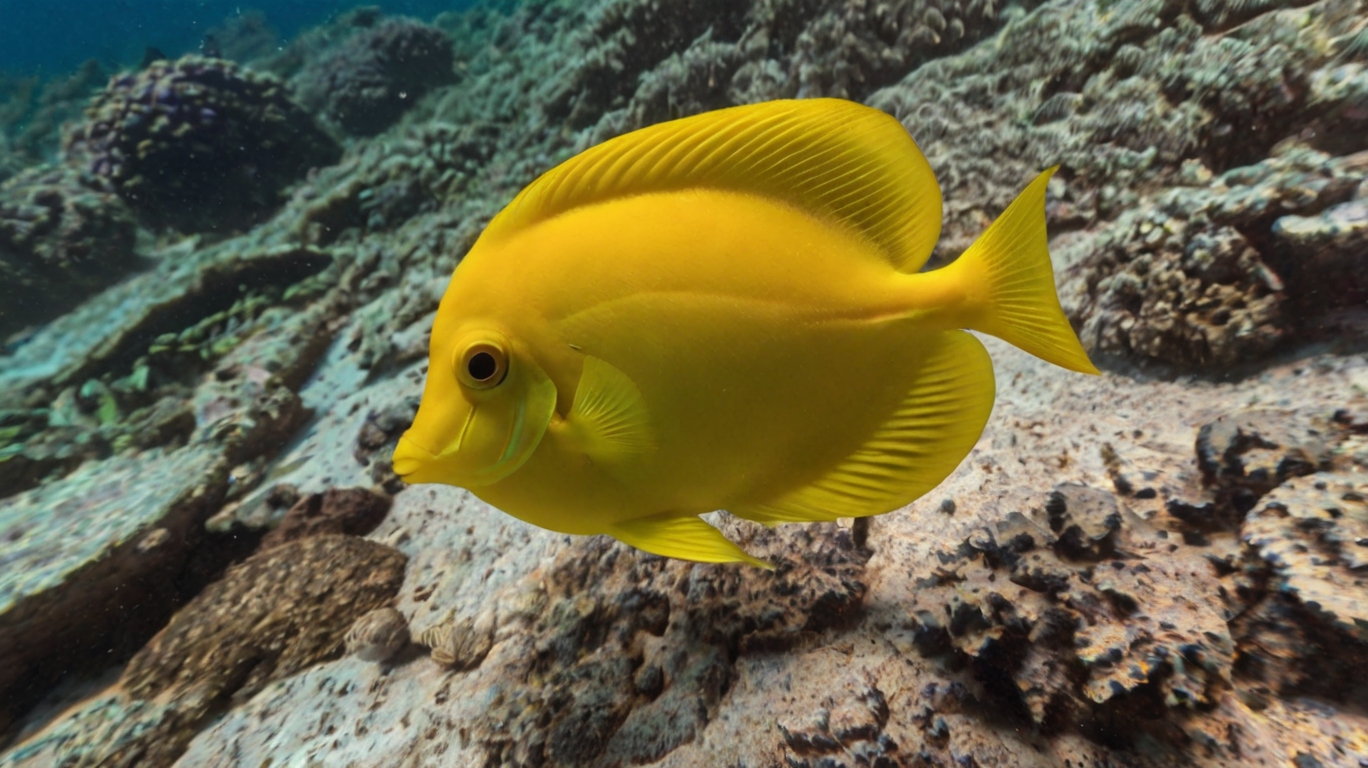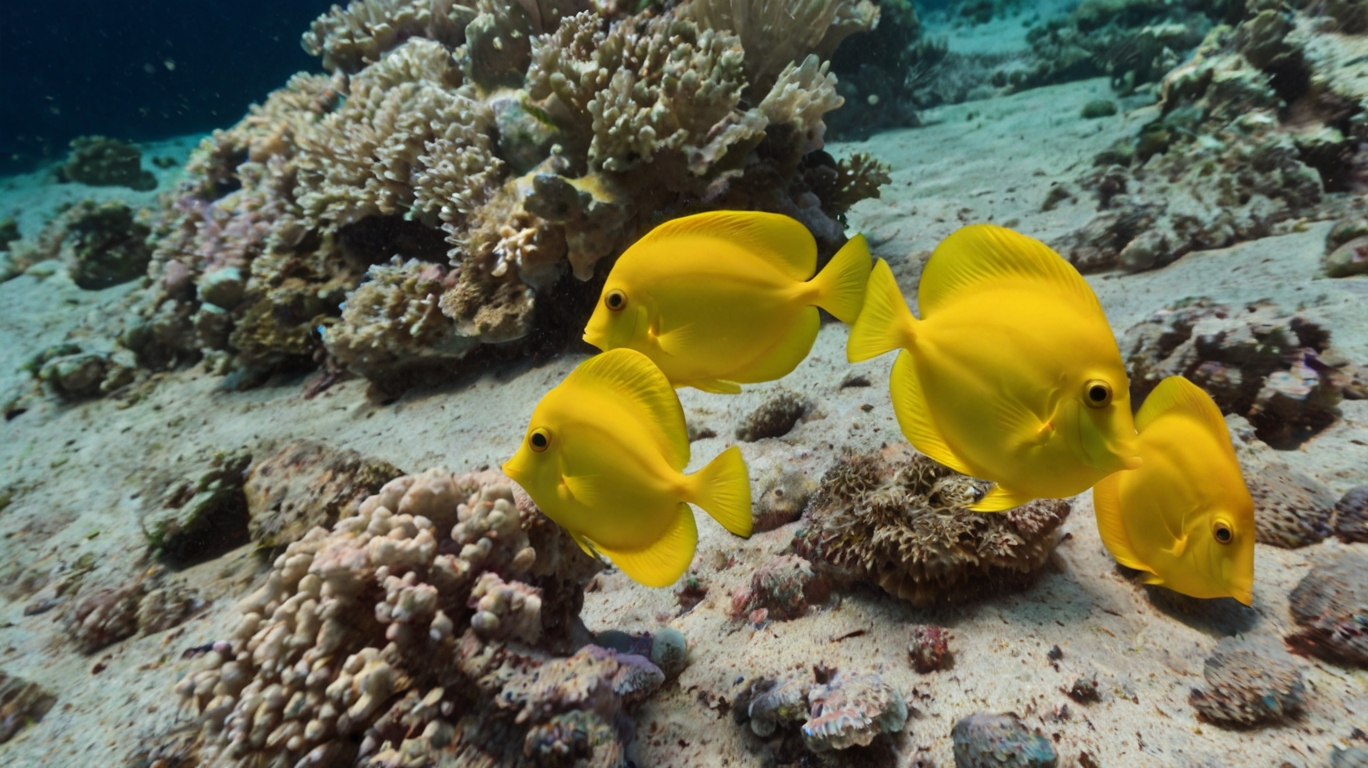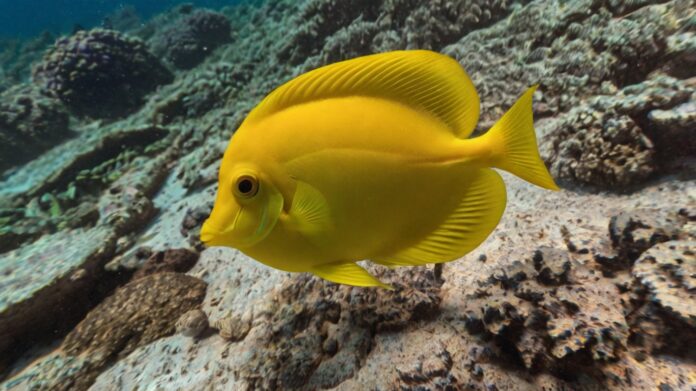
The ocean is full of amazing creatures, each with its own unique beauty. Among these, the yellow tang fish stands out with its bright, cheerful color. This small fish, that scientific name is Zebrasoma flavescens, is a favorite among marine life enthusiasts. Let’s dive deeper into the world of the yellow tang fish and discover why it is such a fascinating creature.
A Burst of Color
One of the first things you’ll notice about the yellow tang fish is its vibrant yellow color. This bright hue makes it easy to spot among the corals and rocks of its natural habitat. The yellow tang’s color isn’t just for show; it also plays a role in its survival. The bright yellow helps the fish blend in with the coral reefs, where it can hide from predators.
Where Do Yellow Tangs Live?
Yellow tangs are live in warm waters of the Pacific Ocean. They are commonly found around the reefs of Hawaii, which is why they are sometimes called Hawaiian yellow tangs. These fish prefer shallow waters, usually between 2 to 46 meters deep in occean. Here, they can find plenty of algae to eat and lots of places to hide from danger.
What Do Yellow Tangs Eat?
Yellow tangs are herbivores, which means they eat only plants. Their favorite food is algae. Algae grow abundantly on the coral reefs, providing a constant supply of food. By eating algae, tang fishes help keep the coral reefs healthy. Too much algae can smother corals and prevent them from getting the sunlight they need to grow. So, in a way, tang fishes are like gardeners of the sea, keeping the reefs clean and healthy.
Life in the Aquarium
Due to their bright color and active nature, yellow tang fish are popular for home aquariums. If you are thinking about getting a tang fish for your aquarium, there are a few things to keep in mind. First, these fish need a lot of space to swim. A tank of at least 100 gallons is needed. They also need plenty of hiding spots and a good amount of algae or algae-based food to eat.
It’s also important to note that yellow tang fish can be territorial. They may become aggressive towards other fish, especially if they feel their space is being invaded. To keep the peace, it’s best to introduce tang fishes to the tank last, after other fish have settled in.

Health and Care
Yellow tangs are generally hardy fish, but they can be prone to a few common diseases. One of these is , a parasitic disease that causes white spots on the fish’s body. Good water quality and a healthy diet can help prevent this and other diseases.
If a tang fish does get sick, it’s important to act quickly. Many diseases can be treated with medications available at pet stores, but early detection is key. Regularly check your fish for any signs of illness, such as changes in color, appetite, or behavior.
Reproduction and Lifespan
In the occean, tangs fishes have an interesting way of reproducing. They gather in groups and release their eggs and sperm into the water at the same time. This method increases the chances of fertilization. The eggs then float in the water for a day before hatching into tiny larvae. These larvae drift with the currents until they grow big enough to settle on the reef.
Yellow tang fish can live for quite a long time. In the occean, they can live up to 30 years. In aquariums, with good care, they can live for 10 to 20 years. This long lifespan makes them a long-term commitment for any aquarium owner.
Conservation Status
While yellow tang fish are not currently endangered, they do face some threats. One of the biggest threats is overfishing for the aquarium trade. Each year, thousands of tang fishes are caught and sold to aquarium enthusiasts around the world. This can put pressure on occean populations.
Another threat is habitat destruction. Coral reefs are delicate ecosystems, and they are being damaged by pollution, climate change, and destructive fishing practices. Protecting these habitats is crucial for the survival of tangs fishes and many other marine species.
Fun Facts About Yellow Tangs
- Night Colors: At night, yellow tang fish change color slightly. They develop a white patch near their tail and their bright yellow color becomes a bit duller. This helps them blend in with the dark surroundings and avoid predators.
- Sharp Spines: Yellow tangs fishes have a sharp spine on their tail, which they use for defense. When threatened, they can raise this spine to ward off predators or other fish.
- Busy Cleaners: In the wild, tangs fish often serve as cleaners. They pick off parasites from larger fish, which helps keep those fish healthy. This is another reason why yellow tangs are important members of the reef community.
Tips for Potential Owners
If you’re considering adding a yellow tang to your aquarium, here are some tips to ensure a happy, healthy fish:
- Large Tank: Make sure your tank is at least 100 gallons to provide enough space for swimming.
- Plenty of Algae: Provide a diet rich in algae. You can supplement with algae sheets or specialized fish food.
- Stable Environment: Keep water conditions stable. Regular water changes and monitoring are key.
- Introduce Last: To prevent territorial behavior, introduce the tang fish after other fish have established their territories.
Conclusion
The yellow tang fish is more than just a pretty fish. It plays a vital role in the health of coral reefs and has unique behaviors and characteristics that make it a fascinating subject for study and observation. Whether in the wild or in an aquarium, the tang fish brings a splash of color and life to the underwater world. By understanding and appreciating these vibrant fish, we can ensure they continue to thrive for generations to come.

FAQs About Yellow Tangs
1. What do yellow tangs eat in the wild and in aquariums?
In the wild, yellow tang fish primarily eat algae, which helps keep the coral reefs clean. In aquariums, they can be feed algae sheets, spirulina-based foods, and other vegetable matter. It’s important to provide a diet rich in algae to mimic their natural food sources and keep them healthy.
2. How big do yellow tangs get, and what size tank do they need?
Yellow tangs fish can grow up to 8 inches in length. Due to their active nature and need for swimming space, it’s recommended to keep them in a tank that is at least 100 gallons. Providing plenty of room and hiding spots helps reduce stress and territorial behavior.
3. Are yellow tangs easy to care for?
Yellow tangs are relatively hardy and can be easy to care for with proper tank conditions and diet. However, they require a stable environment with good water quality and regular maintenance. It’s also important to monitor them for signs of common diseases like ich and ensure they have a proper diet rich in algae.
4. Can yellow tangs live with other fish?
Yellow tangs can live with other fish, but they can be territorial, especially with other tangs or similar species. To reduce aggression, it’s best to introduce tang fishes to the tank last, after other fish have established their territories. Providing a large tank with plenty of hiding spots can also help minimize conflicts.
5. How long do yellow tangs live?
In the Ocean, yellow tangs can easily live up to 30 years. In aquariums, with good care and proper conditions, they can live between 10 to 20 years. Their long lifespan makes them a long-term commitment for any aquarium owner, requiring consistent care and attention.

